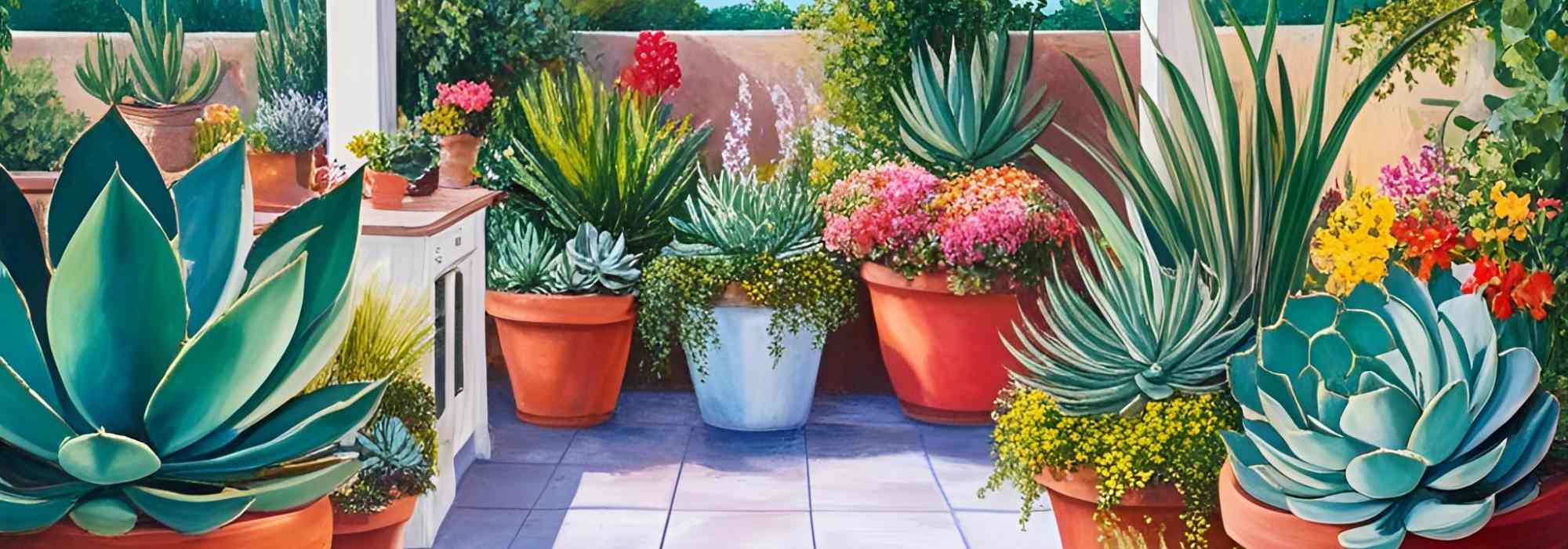
Potscaping or container gardening: a modular and portable Garden
Ways and means of gardening in pots and containers
Contents
Among these English terms gradually making their way into the gardening world, such as foodscaping or slow gardening, here’s a new anglicism for our outdoor designs: potscaping or container gardening, which we simply call pot gardening here.
This concept speaks to everyone and means exactly what it suggests: a collection of potted arrangements, often set up in small spaces, aiming to recreate a garden. These miniature gardens are among the most beautiful examples in urban settings. But nothing stops you from indulging in a lovely collection of pots on your house terrace, in a small courtyard, or even in a corner of the garden. It’s a trend showcased on social media, though it’s not new—city dwellers or time-pressed gardeners have long explored this alternative approach to gardening.
How to style your pots in the most beautiful way? What tips should you know to make your pot garden the perfect illusion of a real garden? Here are some key pieces of advice and ideas to remember!
Potscaping or container gardening – What is it exactly?
The term potscaping is a contraction of the English words “pot” and “landscaping”, referring to the art of gardening in containers. This neologism emerged in the late 1990s with Marjorie Mason Hogue, a Canadian horticulturist. She coined the term and helped popularise the concept in Europe and Canada, particularly through her interest in planting annuals (Ed. note: her book Amazing Annuals remains a reference work). At the time, she spoke of “container garden“, which could be translated as potted garden or garden in pots.
“Potscaping” therefore involves creating a garden through an arrangement of containers rather than traditional flower beds. This practice is appealing due to its ability to make gardening accessible to everyone, even those with only a balcony or terrace. The concept has grown in popularity in recent decades, thanks to the increasing availability of highly decorative garden containers in ceramic, terracotta and other innovative materials, giving pot gardens a distinctive charm.
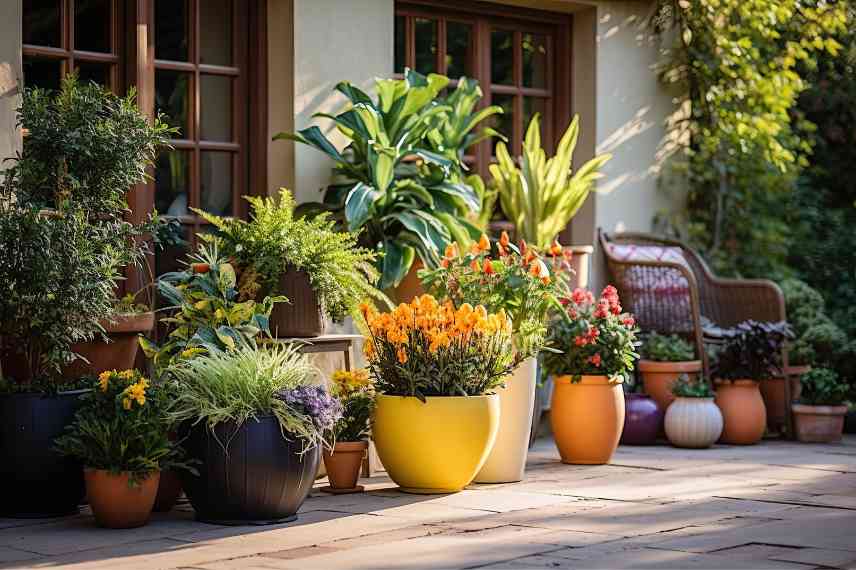
Not just limited to backyards, potscaping also reveals itself on a terrace
Pros and oncs of container gardening
Most of the time, container gardening is considered when the soil is too shallow or of very poor quality for planting directly in the ground, or because of the presence of a concrete slab. It’s an obvious choice for terraces and balconies. Sometimes, advancing age or illness may also prevent the creation and maintenance of a traditional garden. From these constraints actually arise many advantages.
The multiple benefits of container gardening
One could indeed say that container gardening offers almost nothing but advantages! Judge for yourself:
- No soil problems: In a potscaping project, you manage all the substrate in the containers, so you can truly grow whatever you like without worrying about pH levels being too acidic or too alkaline, or soil that drains too much or too little. No more concerns about garden soil that doesn’t suit all plants or ground that’s impossible to plant in.
- The mobility of containers allows them to be moved with the seasons or protected from excessive sun in summer: it’s a mini mobile garden, adaptable at will, and perfect for experimenting every year!
- You can easily refresh your decor by changing some perennial plants and bulbs if desired or reserving certain pots and planters for annuals.
- Usually invasive plants are (finally) contained: mints, oregano, raspberries, loosestrife, ivy, etc.
- Grouped pots protect each other and recreate a small microclimate, effective both during heatwaves and cold spells.
- You can indulge in less hardy plants if you have a frost-free space to store them in winter.
- It’s adaptable to very small spaces, from patios in apartment courtyards to windowsills that can be transformed into lush green displays.
- Container gardening allows for a highly personal universe, often colourful and aesthetic thanks to the materials and hues of the pots: celadon blue, terracotta, etc., and it fits particularly well in contemporary settings.
- It’s also the ideal option for renters, providing greenery and a cosy retreat that’s easy to take along when moving—perhaps to a future, larger garden?
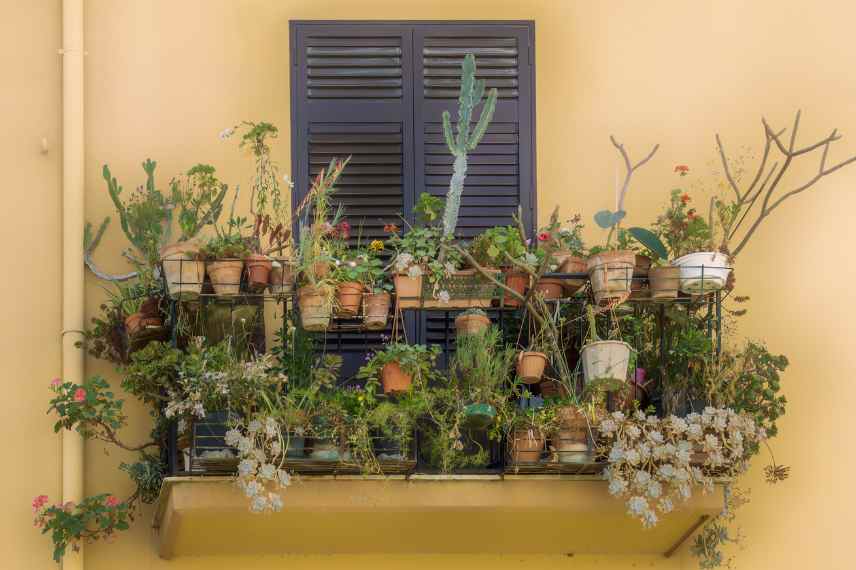
Even a windowsill can be fully greened up, as shown here with a mini container garden
The drawbacks of container gardening
There are few risks in planning a container garden. However, you’ll need to be vigilant about four fundamental aspects, as this planting method is far less self-sufficient.
- Ensure more consistent watering, especially in summer, as the substrate dries out quickly in pots, and consider a drip irrigation system if you’ll be away for long periods in summer. Read more in watering potted plants.
- Fertilise to provide plants with necessary nutrients over time.
- Avoid choosing large specimens (trees are nearly impossible in limited soil volumes; all plants should be selected for suitability in containers).
- Protect pots in winter—essential, as plants are far more vulnerable in containers (mulch pots, use frost cloths on foliage, group near sheltered walls).
Finally, of course, over the years, you’ll need to repot, just as you’d divide perennials in a garden.
Which plants are suitable for a container garden?
A wide range! Succulents and cacti, aromatic herbs, small varieties of bushes, perennials, ornamental grasses, annuals for summer colour, and plants that prefer cool substrates are excellent choices for containers. As long as drainage is well managed, you can indulge in your favourite plants, just be aware that their growth will be more limited than if planted in the ground, and always remain vigilant about watering. Of course, potscaping works for both shady and sunny gardens, just like its big brother!
It’s preferable and interesting to focus on:
- Compact, dwarf or columnar varieties among bushes and fruit trees – they take up less space (like Star Magnolia, dwarf cherries such as ‘Yamadei’, Miscanthus ‘Cute One’…)
- Ball-shaped or standard-trained plants: to save space in small areas.
- Trailing plants for balcony railings (Convolvulus cneorum, Muehlenbeckia…) and climbing plants like star jasmine or many small-flowered clematis.
- Slow-growing bushes, like Japanese maples, and many heather soil plants.
- Drought-resistant plants that tolerate container conditions: Anthemis, Dianthus, etc.
- Plants that prefer being root-bound (Aspidistra, Agapanthus… see a wider selection here).
- Exotic-looking plants that make an impact on balconies (some may need winter protection: Aspidistra, Cycas, Cordyline, Farfugiums…)
- A mix (just like in gardens!) of evergreen and deciduous foliage plants for year-round volume and autumn colours. For example, some Leucothoe, Skimmia or Pittosporum ‘Nanum’ among evergreens, Physocarpus ‘Little Joker’ among deciduous plants.
- Succulents to minimise watering chores: this container garden is full of character, drawing all eyes to a sunny windowsill or sheltered south-facing spot.
- Thirsty plants, provided they’re planted in containers without drainage holes or closely monitored in summer: Arums, Cannas, marsh Hibiscus, Fuchsias, Farfugiums, hostas, some marginal aquatics like Lysimachia, etc.
- Annuals to ensure summer flowering.
Find more inspiration with our features: Which plants for a contemporary balcony?, Which plants for a zen balcony?, Which plants for a romantic balcony? and Which plants for an exotic balcony?; 7 fast-growing perennials for containers; The best bulbs for containers.
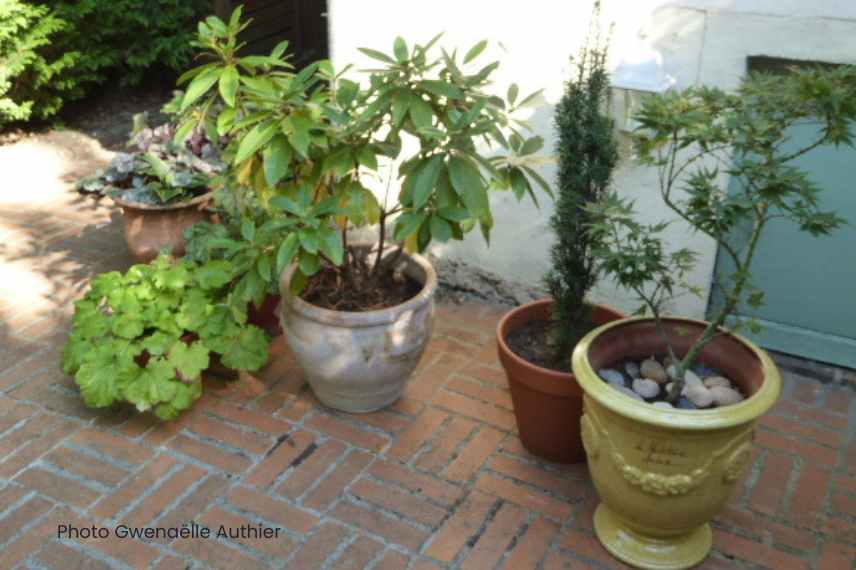
Rhododendron, Japanese Maple, Heucheras and Taxus in a small Parisian courtyard
How to choose your pots and planters?
The range of pots, planters and containers of all kinds is extensive. A few key points are essential for container gardening:
- Plants with deep root systems are rarely suitable, but some dwarf roses thrive very well in pots. The depth of the pot should therefore be adapted to the type of plant chosen.
- The size of the pot also depends on the selected plants, and should be large enough to ensure minimal autonomy for the plants.
- For a balcony, small garden or flexible space, prioritise lightweight materials: resin, plastic or fibreglass, terracotta lookalikes…
- On a balcony or roof terrace, beware of the combined weight of pots and any building regulations.
Beyond the container itself, drainage through the addition of clay pebbles or choosing a well-draining substrate (for succulents, acidophilous or Mediterranean plants) is essential. We’ve explored this topic extensively in our advice section: I’ll tell you more in our ABC of Container Planting, and Olivier in Plastic, Biodegradable or Terracotta Pots.
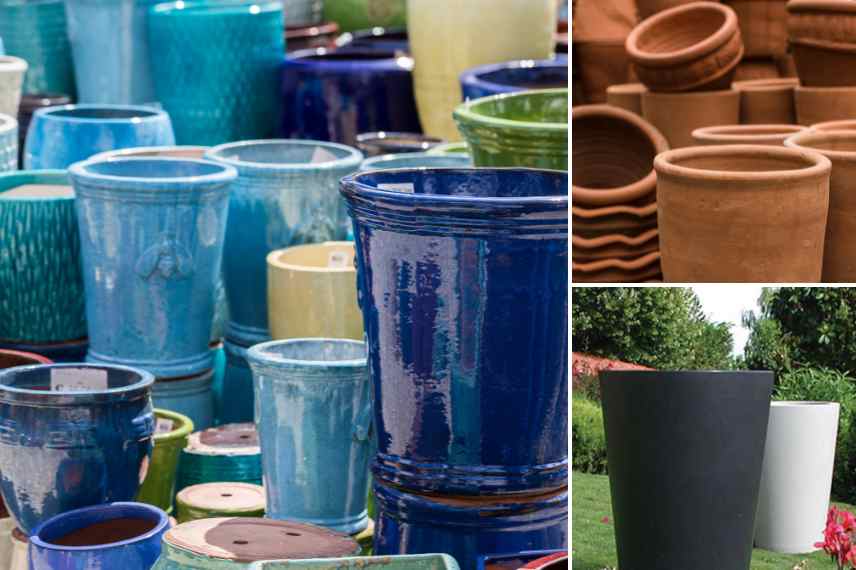
The vast range of pots on the market allows you to create a personalised container garden, colourful or more versatile, traditional or with contemporary flair
Strategic spots for container gardening
When space is limited, container gardening offers many advantages and can be considered in various situations:
- On balconies and terraces: the classic location. A collection of pots looks magnificent when planted with exotic, Japanese-inspired or lush plants. They require special care as they are usually visible from the living area.
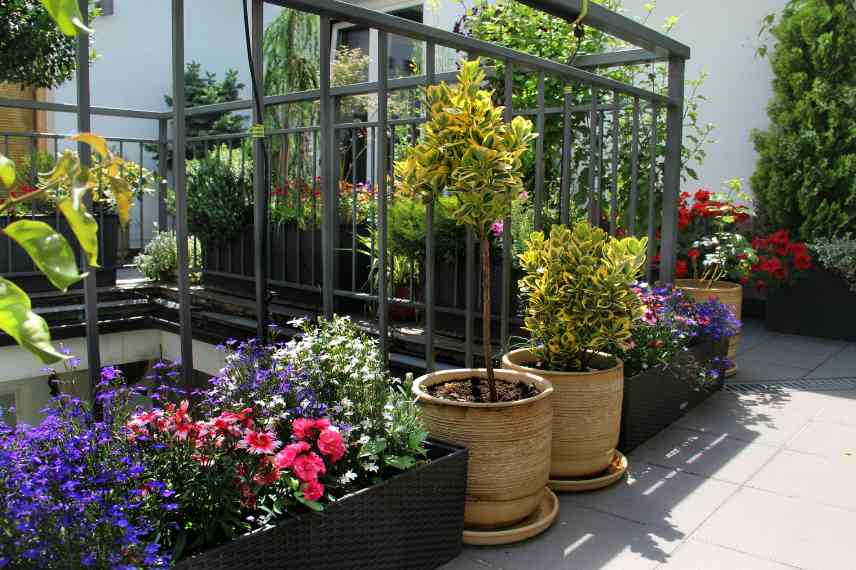
Pots always add elegance to hard surfaces like terraces
- In a backyard or patio, often featuring magical shade-loving plants in pots: Fatsia japonica, hostas, heucheras, Aspidistras, Mahonias, etc.
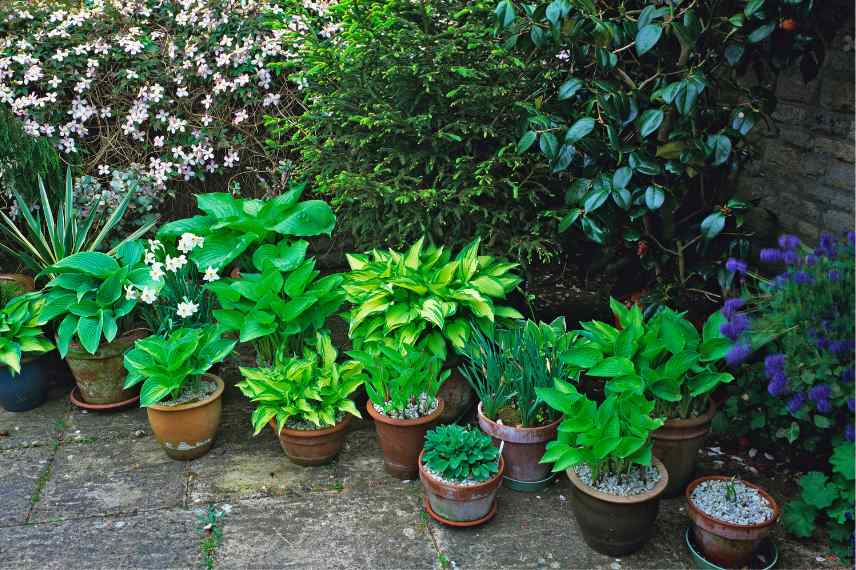
Here, a hosta collection brightens up a building courtyard
- At the entrance of a house, inspired by Mediterranean villages where gardens often consist of a small space filled with welcoming potted plants.
- Around the house to connect it to the garden, or even within the garden on a paved area, where they create a distinct plant scene.
- Against a dull and dreary wall, transforming it with hanging pots like in the patios of Córdoba!
- On the street, embracing Mediterranean styles with rows of pots, either with full-sun plants or shade-loving plants, depending on exposure.
- On a windowsill: perfect for mini plants, a collection of cacti in full sun for example, handy herbs or annuals until frost.
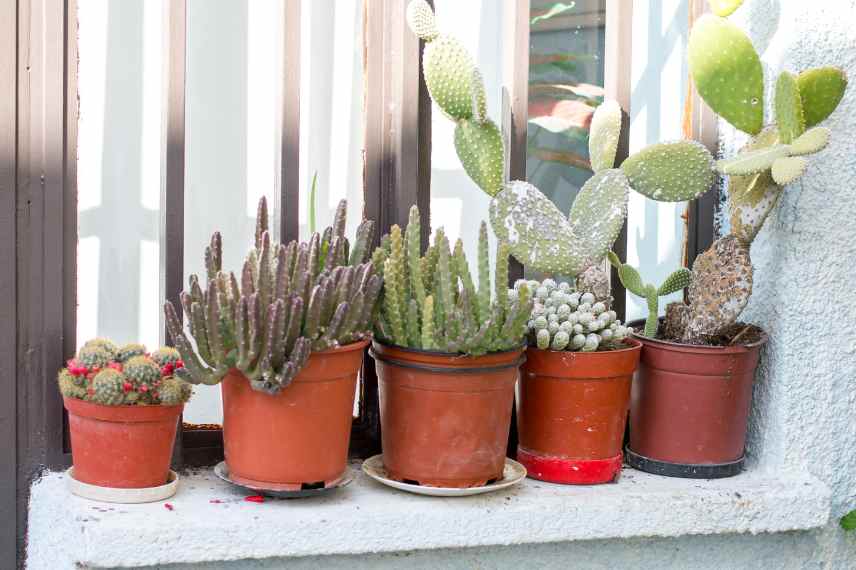
The always successful effect of a row of small cacti pots
→ Learn more in How to create a welcoming entrance? and Brightening an entrance with climbing plants.
How to best arrange your space? Tips and mistakes to avoid
Creating a container garden isn’t just about choosing the right plants and pots. You need to approach it like a traditional garden, highlighting a particular atmosphere while carefully positioning the containers to showcase them. Here are some tips to elevate your potted garden:
- The art of pot placement: This is the heart of the matter! Sticking to the same material, colour, or style is essential to avoid visual chaos. Varying pot sizes and shapes (small containers, taller and more voluminous pots) add rhythm and allow for planting radically different types of plants. Ingrid discusses this in detail in How to arrange pots on a terrace?
- Play with accumulation, a beloved approach in potscaping: plant in mass, at least five pots, preferably in odd numbers (5,7,9).
- Find your garden style: Japanese or Mediterranean, exotic, contemporary, or romantic to create a coherent theme. This may stem from the material of your pots (terracotta for Mediterranean) or simply from your personal tastes.
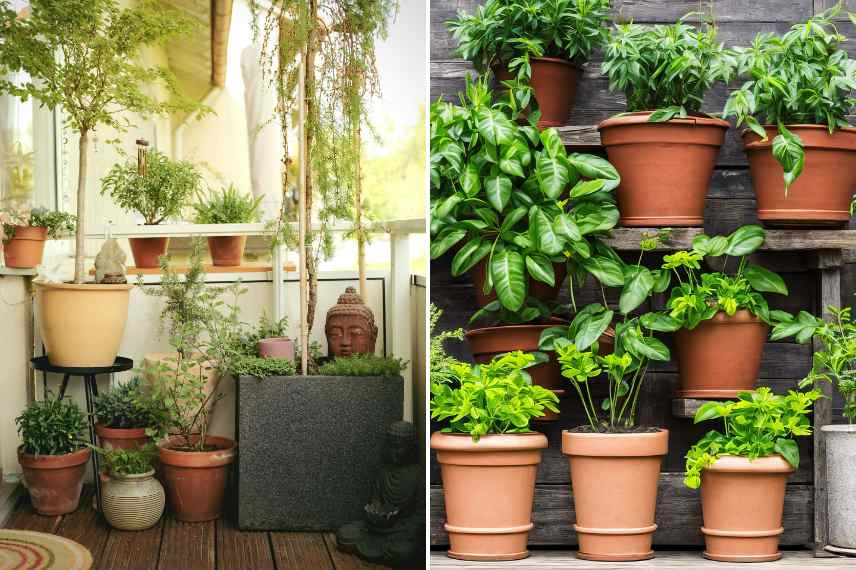
If possible, tier your pots on a balcony using the railing, mix different container sizes, and set up a lovely shelf
- Combine plants of different volumes: upright, tabular, columnar plants, as well as climbing and trailing varieties. The same rule as traditional gardening applies, with taller plants at the back and shorter ones in front.
- Group potted plants close together to create shade and a micro climate, as well as a mass effect.
- Play with verticality or elevation (walls, benches, ladders, shelves, trellises, and hanging displays) to add height and maximise space.
- Draw inspiration from small Mediterranean villages, where the soil is often unsuitable for traditional gardens.
- Add gravel, aggregate, or wooden decking to cover bare soil, which is often unsightly.
- Showcase small, unusual, or rare plants
- Combine plants with similar water and light needs, perhaps in the same container. Cacti and succulents can be grouped together, as can Mediterranean herbs.
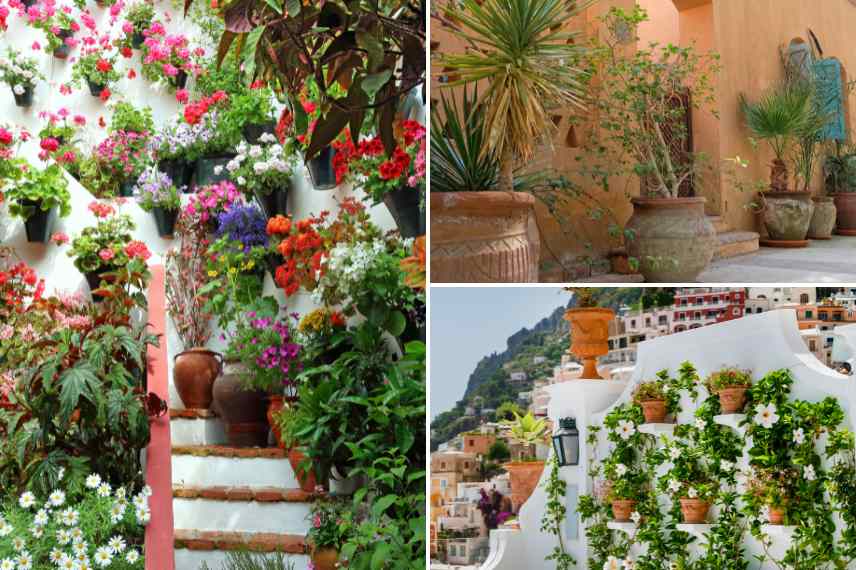
Like in Andalusia, Greece, Italy, or Morocco, take inspiration from patios and riads, often featuring vertical planting in pots
Mistakes to avoid
There are a few pitfalls to container gardening, which we summarise here:
- If you can’t bring plants indoors in cold winter regions, only choose hardy plants, as their hardiness is reduced in pots.
- Going in all directions with plants that lack coherence: use their flower colours and graphic foliage to create a distinct atmosphere.
- Avoid symmetry, except in contemporary settings.
- Placing pots haphazardly by cramming them together.
- Neglecting maintenance (read Ingrid’s advice in How to clean your flower pots)
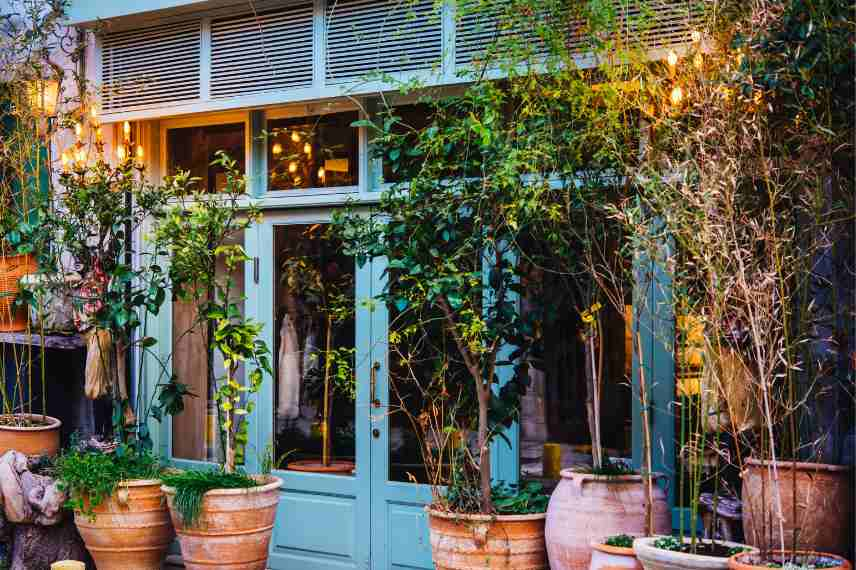
Harmonious materials highlight both the pot… and the plant!
Going further: inspiration and recommended reading
Our advice section Balconies and Terraces explores the countless possibilities of container planting. Have a look!
Discover more images and ideas for plants suited to Potscaping in our 2025 trends booklet, pages 26 to 29.
Finally, several books focus on container gardening and are full of beautiful ideas and inspiring photos. I recommend our selection in our online bookshop, with these well-thought-out books:
- Growing in Pots All Year Round. Courtyard, Balcony, Patio or Simply Planters by Harriet Rycroft and Andrew Maybury. Éditions Ulmer. 2024.
- Small Modern Gardens, by Noel Kingsbury. Éditions Ulmer.
- Subscribe!
- Contents




































Comments